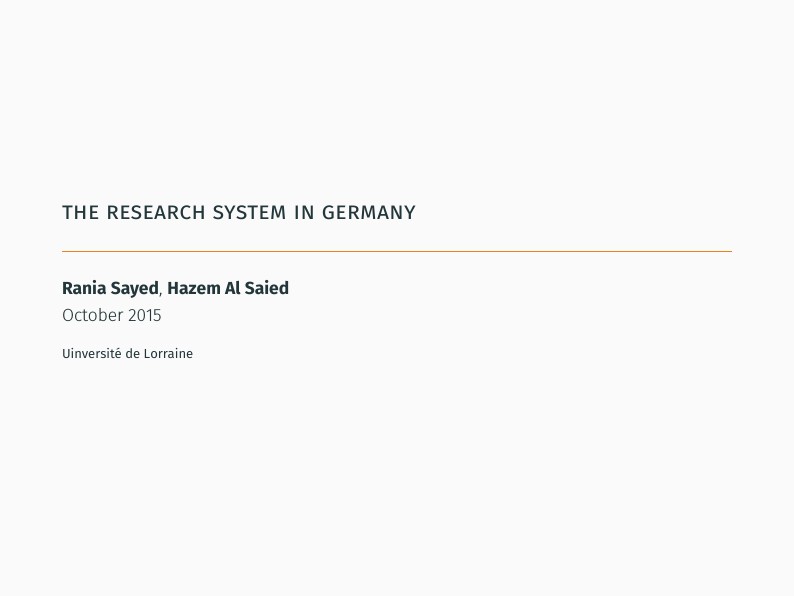
The research system in Germany
Author:
hazem alsaied
Last Updated:
10 anni fa
License:
Creative Commons CC BY 4.0
Abstract:
The research system in Germany

\begin
Discover why over 20 million people worldwide trust Overleaf with their work.
The research system in Germany

\begin
Discover why over 20 million people worldwide trust Overleaf with their work.
%!TEX program = xelatex
\documentclass[9pt, compress]{beamer}
\usetheme[titleprogressbar]{m}
\usepackage{booktabs}
\usepackage[scale=2]{ccicons}
\usepackage{minted}
\usepgfplotslibrary{dateplot}
\usemintedstyle{trac}
\author{\textbf{Rania Sayed}, \textbf{Hazem Al Saied} }
\title{The research system in Germany}
%\subtitle{}
%\logo{}
\institute{\textbf{Uinversité de Lorraine}}
\date{October 2015}
%\subject{}
%\setbeamercovered{transparent}
%\setbeamertemplate{navigation symbols}{}
\begin{document}
\maketitle
\begin{frame}
\frametitle{Outlines}
\tableofcontents{}
\end{frame}
\section{Introduction}
\begin{frame}
\frametitle{Introduction}
\begin{itemize}
\item Germany has one of the largest research systems in the OECD
\item there are nearly 1,000 public funded institutions of science, research and development in Germany
\end{itemize}
\end{frame}
\begin{frame} %BilantInfo
\frametitle{Introduction 2}
\includegraphics[width=\textwidth,height=300pt]{img/no_researchers.jpg}
\end{frame}
\section{Overview of the German research system}
\begin{frame}
\frametitle{Overview of the German research system}
\begin{figure}
\includegraphics[width=\textwidth,height=150pt]{img/R_org_graph.jpg}
\caption{Distribution of budget on different sectors}
\end{figure}
\end{frame}
\begin{frame}
\frametitle{Overview of the German research system}
Public funding for different aspects of research is organised in one of three ways:
\begin{itemize}
\item From federal sources (e.g. project funding);
\item From state sources (e.g. institutional funding for higher education
institutions, state R\&D institutions);
\item Jointly from federal and state sources according to agreed formula (e.g.institutional funding of public research institutes of national significance; project funding for universities;categories of research infrastructure).
\end{itemize}
\end{frame}
\section{Research Organisations}
\begin{frame}
\frametitle{Research Organisations}
\begin{figure}
\includegraphics[width=\textwidth,height=175pt]{img/ResearchOrg.jpg}
\caption{Overview of research-performing organisations in Germany}
\end{figure}
\end{frame}
\subsection{Public research institutes}
\begin{frame}
\frametitle{Public research institutes}
Public research institutes are organised into four large networks:
\begin{itemize}
\item The Max Planck Gesellschaft (MPG)
\item The Fraunhofer Gesellschaft (FhG)
\item The Helmholtz-Gemeinschaft Deutscher Forschungszentren (HGF)
\item The Wissenschaftsgemeinschaft Wilhelm-Gottfried-Leibniz (WGL)
\end{itemize}
\end{frame}
\subsection{Research Activities}
\begin{frame}
\frametitle{Research Activities}
\centering
\includegraphics[scale=0.7]{img/Domain_Res.jpg}
\end{frame}
\section{Research Funding System }
\begin{frame}
\frametitle{Funding types in Germany}
\begin{itemize}
\item\textbf{ Government Funding}
\begin{itemize}
\item more than 390 public universities and colleges are funded by the Länder.
\end{itemize}
\end{itemize}
\begin{itemize}
\item\textbf{ The European Funding}
\end{itemize}
\begin{itemize}
\item\textbf{ The Industrial Funding}
\begin{itemize}
\item In 2012, German companies spending amounted to a total of 2.5 billion euros.
\end{itemize}
\end{itemize}
\end{frame}
\begin{frame}
\includegraphics[width=\textwidth,height=175pt]{img/FundingoResearch.png}
\newline
\centering
Figure Shows the collaboration between the federal and states governments.
\end{frame}
\section{PHD Student }
\begin{frame}
\frametitle{PHD Student}
\begin{quotation}
4,000 international graduates complete their doctorate in Germany every year.
\end{quotation}
\begin{itemize}
\item five reasons to do your PhD in Germany:
\begin{enumerate}
\setcounter{enumi}{0}
\item Outstanding reputation of German doctorate
\item Strong international focus: PhD in English
\item Good funding opportunities
\item Excellent research infrastructure
\item High standard of living
\end{enumerate}
\end{itemize}
\end{frame}
\subsection{Ways to do th PHD in Germany}
\begin{frame}
\frametitle{Ways to do the PHD in Germany}
\begin{enumerate}
\setcounter{enumi}{0}
\item \textbf{Individual Doctorate}
\begin{itemize}
\item Involves the thesis produced under the supervision of a professor.
\item Three to five years are normal.
\end{itemize}
\item \textbf{Structured PhD Programs}
\begin{itemize}
\item A team of supervisors look after a group of doctoral students.
\item The duration of studies is limited to three years.
\end{itemize}
\end{enumerate}
\end{frame}
\subsection{Computer science}
\begin{frame}
\frametitle{Computer science}
programs and organizations each PhD student should know :
\begin{enumerate}
\setcounter{enumi}{0}
\item \textbf{Bitkom}
\begin{itemize}
\item Represent more than 2,300 companies in the digital economy.
\end{itemize}
\item \textbf{BMBF}
\begin{itemize}
\item Drives more than 80 per cent of innovations in Germany.
\end{itemize}
\item \textbf{Action Program iD2010}
\begin{itemize}
\item Coordinates funding programs, to ensure that the information society can develop further.
\end{itemize}
\end{enumerate}
\end{frame}
\subsection{Funding PhD in Germany}
\begin{frame}
\frametitle{Funding PhD in Germany: Costs of Study}
\includegraphics[width=\textwidth,height=150pt]{img/cost.png}
\begin{center}
How much “normal students” spend per month in Germany.
\end{center}
\end{frame}
\begin{frame}
\frametitle{Funding Models}
\begin{quotation}
In 2012, DAAD supported over 4,700 international doctoral students in Germany with scholarships.
\end{quotation}
\begin{enumerate}
\setcounter{enumi}{0}
\item \textbf{SCHOLARSHIPS}
\item \textbf{RESEARCH ASSOCIATE JOBS}
\begin{itemize}
\item As a rule, doctoral candidates work at the chair of their supervising professor as research associates with temporary part-time contracts.
\end{itemize}
\item \textbf{SIDE JOBS OUTSIDE RESEARCH}
\end{enumerate}
\end{frame}
\begin{frame}
\frametitle{Funding Databases}
\begin{enumerate}
\setcounter{enumi}{0}
\item \textbf{DAAD Scholarship Database}
\begin{itemize}
\item German Academic Exchange Service (DAAD) is the largest awarder of scholarships.
\end{itemize}
\item \textbf{EURAXESS Funding Database}
\begin{itemize}
\item Comprises more than 100 programs offered by funding organizations in Germany.
\end{itemize}
\item \textbf{Stipendienlotse}
\begin{itemize}
\item Is the database of the Federal Ministry of Education and Research (BMBF)
\end{itemize}
\end{enumerate}
\end{frame}
\section{Conclusion}
\begin{frame}
\frametitle{Conclusion}
\begin{itemize}
\item Research in Germany is characterised by an excellent infrastructure, a wide variety of disciplines, well-equipped research facilities and competent staff.\\
\item Germany offers various forms of research locations: universities, non-university institutes, companies and institutions run by federal or state (“Länder”) authorities.\\
\item There are more than 800 publicly funded research institutions in Germany, plus research and development (R\&D) centres run by companies.
\end{itemize}
\end{frame}
\end{document}